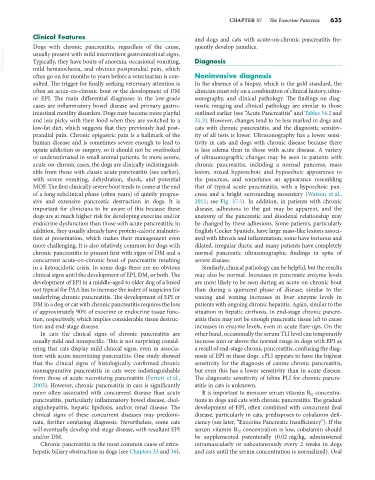Page 663 - Small Animal Internal Medicine, 6th Edition
P. 663
CHAPTER 37 The Exocrine Pancreas 635
Clinical Features and dogs and cats with acute-on-chronic pancreatitis fre-
Dogs with chronic pancreatitis, regardless of the cause, quently develop jaundice.
VetBooks.ir usually present with mild intermittent gastrointestinal signs. Diagnosis
Typically, they have bouts of anorexia, occasional vomiting,
mild hematochezia, and obvious postprandial pain, which
often go on for months to years before a veterinarian is con- Noninvasive diagnosis
sulted. The trigger for finally seeking veterinary attention is In the absence of a biopsy, which is the gold standard, the
often an acute-on-chronic bout or the development of DM clinician must rely on a combination of clinical history, ultra-
or EPI. The main differential diagnoses in the low-grade sonography, and clinical pathology. The findings on diag-
cases are inflammatory bowel disease and primary gastro- nostic imaging and clinical pathology are similar to those
intestinal motility disorders. Dogs may become more playful outlined earlier (see “Acute Pancreatitis” and Tables 34.2 and
and less picky with their food when they are switched to a 34.3). However, changes tend to be less marked in dogs and
low-fat diet, which suggests that they previously had post- cats with chronic pancreatitis, and the diagnostic sensitiv-
prandial pain. Chronic epigastric pain is a hallmark of the ity of all tests is lower. Ultrasonography has a lower sensi-
human disease and is sometimes severe enough to lead to tivity in cats and dogs with chronic disease because there
opiate addiction or surgery, so it should not be overlooked is less edema than in those with acute disease. A variety
or underestimated in small animal patients. In more severe, of ultrasonographic changes may be seen in patients with
acute-on-chronic cases, the dogs are clinically indistinguish- chronic pancreatitis, including a normal pancreas, mass
able from those with classic acute pancreatitis (see earlier), lesion, mixed hyperechoic and hypoechoic appearance to
with severe vomiting, dehydration, shock, and potential the pancreas, and sometimes an appearance resembling
MOF. The first clinically severe bout tends to come at the end that of typical acute pancreatitis, with a hypoechoic pan-
of a long subclinical phase (often years) of quietly progres- creas and a bright surrounding mesentery (Watson et al.,
sive and extensive pancreatic destruction in dogs. It is 2011; see Fig. 37.5). In addition, in patients with chronic
important for clinicians to be aware of this because these disease, adhesions to the gut may be apparent, and the
dogs are at much higher risk for developing exocrine and/or anatomy of the pancreatic and duodenal relationship may
endocrine dysfunction than those with acute pancreatitis; in be changed by these adhesions. Some patients, particularly
addition, they usually already have protein-calorie malnutri- English Cocker Spaniels, have large mass-like lesions associ-
tion at presentation, which makes their management even ated with fibrosis and inflammation; some have tortuous and
more challenging. It is also relatively common for dogs with dilated, irregular ducts; and many patients have completely
chronic pancreatitis to present first with signs of DM and a normal pancreatic ultrasonographic findings in spite of
concurrent acute-on-chronic bout of pancreatitis resulting severe disease.
in a ketoacidotic crisis. In some dogs there are no obvious Similarly, clinical pathology can be helpful, but the results
clinical signs until the development of EPI, DM, or both. The may also be normal. Increases in pancreatic enzyme levels
development of EPI in a middle-aged to older dog of a breed are most likely to be seen during an acute-on-chronic bout
not typical for PAA has to increase the index of suspicion for than during a quiescent phase of disease, similar to the
underlying chronic pancreatitis. The development of EPI or waxing and waning increases in liver enzyme levels in
DM in a dog or cat with chronic pancreatitis requires the loss patients with ongoing chronic hepatitis. Again, similar to the
of approximately 90% of exocrine or endocrine tissue func- situation in hepatic cirrhosis, in end-stage chronic pancre-
tion, respectively, which implies considerable tissue destruc- atitis there may not be enough pancreatic tissue left to cause
tion and end-stage disease. increases in enzyme levels, even in acute flare-ups. On the
In cats the clinical signs of chronic pancreatitis are other hand, occasionally the serum TLI level can temporarily
usually mild and nonspecific. This is not surprising consid- increase into or above the normal range in dogs with EPI as
ering that cats display mild clinical signs, even in associa- a result of end-stage chronic pancreatitis, confusing the diag-
tion with acute necrotizing pancreatitis. One study showed nosis of EPI in these dogs. cPLI appears to have the highest
that the clinical signs of histologically confirmed chronic sensitivity for the diagnosis of canine chronic pancreatitis,
nonsuppurative pancreatitis in cats were indistinguishable but even this has a lower sensitivity than in acute disease.
from those of acute necrotizing pancreatitis (Ferreri et al., The diagnostic sensitivity of feline PLI for chronic pancre-
2003). However, chronic pancreatitis in cats is significantly atitis in cats is unknown.
more often associated with concurrent disease than acute It is important to measure serum vitamin B 12 concentra-
pancreatitis, particularly inflammatory bowel disease, chol- tions in dogs and cats with chronic pancreatitis. The gradual
angiohepatitis, hepatic lipidosis, and/or renal disease. The development of EPI, often combined with concurrent ileal
clinical signs of these concurrent diseases may predomi- disease, particularly in cats, predisposes to cobalamin defi-
nate, further confusing diagnosis. Nevertheless, some cats ciency (see later, “Exocrine Pancreatic Insufficiency”). If the
will eventually develop end-stage disease, with resultant EPI serum vitamin B 12 concentration is low, cobalamin should
and/or DM. be supplemented parenterally (0.02 mg/kg, administered
Chronic pancreatitis is the most common cause of extra- intramuscularly or subcutaneously every 2 weeks in dogs
hepatic biliary obstruction in dogs (see Chapters 33 and 36), and cats until the serum concentration is normalized). Oral

